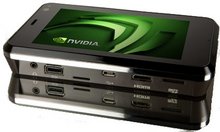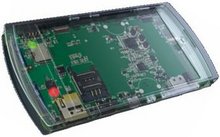NVidia enters mobile SoC market — but where’s the Linux?
Feb 13, 2008 — by LinuxDevices Staff — from the LinuxDevices Archive — 4 views Attesting to the primacy of devices in the computing world, GPU and desktop chipset vendor Nvidia is sampling its first-ever mobile applications processor. The ARM11-based APX 2500 boasts HD (720p) graphics, an HDMI interface, and a super-low power ULP GeForce core.
Attesting to the primacy of devices in the computing world, GPU and desktop chipset vendor Nvidia is sampling its first-ever mobile applications processor. The ARM11-based APX 2500 boasts HD (720p) graphics, an HDMI interface, and a super-low power ULP GeForce core.
(Click here for a larger view of Nvidia's APX 2500)
The APX 2500 supports only Windows Mobile at this point, but a prototype using the processor has been rumored to have been seen running the Linux-based Google Android phone stack. Nvidia is a member of the Open Handset Alliance (OHA) group overseeing the Android specification.
Nvidia provided no packaging information for the APX 2500 and said only that “specifications could vary by motherboard manufacturer.” However, the system-on-chip (SoC) will apparently be offered as part of a development platform (below) that also includes components from Atheros, Infineon, NXP, and Wolfson, among other companies.


Nvidia's APX 2500 development platform has an HDMI port
(Click either view to enlarge)
The APX 2500 is based on an ARM11 core supporting ARM's “MPCore” interconnect technology for multi-core designs. However, the chip itself appears to have only a single core. On-chip memory controllers support low-power DDR RAM, and both NOR and NAND flash.
The processor's graphics capabilities are what make it distinctive. This is the industry's first processor for handheld devices that can play back or capture 720p HD video. According to Nvidia, it encodes 720p H.264 and MPEG-4, and plays back those formats along with VC-1/WMV9 video streams.
In addition, the device's ULP GeForce core is the “lowest-power 3D hardware solution available,” according to Nvidia. The core has the following touted features and benefits:
- OpenGL for Embedded Systems (OpenGL ES) 2.0 compatibility
- Direct 3D Mobile
- Programmable pixel shader
- Programmable vertex and lighting
- Coverage Sampled Anti-aliasing (CSAA) support
- Advanced 2D graphics
Nvidia says devices built using the APX 2500 can have cameras up to 12 megapixels, and can also connect to external LCD or CRT displays, with resolution up to SXGA (1280 x 1024 pixels). TV output supports composite, S-video, and HDMI connectors, with resolution up to 1280 x 720.
Nvidia says it will partner with a variety of vendors to integrate the APX 2500 into a Windows Mobile-based development platform. The platform will apparently be the first smartphone to feature an HDMI port for video output. The platform will incorporate Atheros' ROCm wireless networking, Infineon's XMM 6080 HSDPA modem technology, NXP's PCF50626 power management unit, and Wolfson's WM8753 audio codec, according to Nvidia.
In 2006, Nvidia announced an earlier development kit for Windows Mobile phones, the MobileMedia Platform. This became the basis of an unusual hard-drive equipped phone from Samsung, the SGH i310. More recently, I-Mate adopted Nvidia's GoForce 5500 graphics processing unit on its Ultimate 6150 and 8150 phones, giving them the unusual capability of connecting to external XGA (1024 x 768) monitors.
The APX 2500 supports the OpenKODE 1.0 API, which is touted as a royalty-free alternative to Microsoft DirectX, designed primarily for mobile game developers. It was the only hardware-based product to announce support for the cross-platform multimedia API spec when the Khronos Group announced the OpenKODE 1.0 release this week.
Availability
Nvidia says the APX 2500 applications processor “is sampling today with key customers and will enter into full production by the end of Q2 2008.” No separate information was provided on the development kit.
This article was originally published on LinuxDevices.com and has been donated to the open source community by QuinStreet Inc. Please visit LinuxToday.com for up-to-date news and articles about Linux and open source.